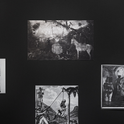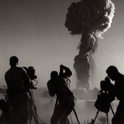Angels of Anarchy: Women Artists and Surrealism
26th September to 10th January 2010, Manchester Art Gallery
Women are often the subjects of surrealist art: dismembered, deliquescent, with doors in their stomachs, breasts for eyes and so forth. More elusive, however, are women as proponents of surrealist art. Lee Miller and Frida Kahlo are the star names; general surveys of the movement also tend to include a few individual works by women--Meret Oppenheim's Object (a teacup, saucer and spoon covered in fur, 1936), Leonora Carrington's shock-haired Self-Portrait (1938) with rocking horse and Eileen Agar's sculpture of a scarf-shrouded head, Angel of Anarchy (1936-40). But, as a new exhibition in Manchester shows, there are many more heroines of surrealism who have been sidelined from the canon.
The alpha males of surrealism are among the best-known names in 20th-century art: André Breton, Salvador Dalí, Marcel Duchamp, Max Ernst, Man Ray, Joan Miró. So why haven't we heard of Emmy Bridgewater, whose influence on the British movement was—according to the French critic Michel Remy—as powerful as Dalí's in France? Search for her name in the British Library and there is only one return, a flimsy exhibition catalogue. And why haven't we heard of the devoted lesbian stepsisters of Jersey, Claude Cahun and Marcel Moore? They fought the Nazi occupation of the island with a campaign of subversive propaganda, some of it in rhyme. Yet instead of getting the Hollywood biopic they clearly deserve, they tend to be discussed only in journals of gender studies.
The 33 women artists in this exhibition remain in relative obscurity for many reasons. Lack of original talent is not one of them. Critical carping is. To research women Surrealists is to encounter either silence or polite derision from the art establishment. The last major international show to group these contemporaries together was in 1943, at Peggy Guggenheim's gallery in New York. It proved, according to one critic, that women were better at surrealism than men. Really? Be still, my beating heart. "This is logical now one comes to think of it," the critic continues, “since surrealism is about 70 per cent hysterics…"
Critics love to patronise a safe target, and what could be safer than a half-forgotten dead lady artist? Even this Manchester show includes in its catalogue an essay in which a critic looks down his nose at some of the work. The critic, Roger Cardinal, examines Leonor Fini's The Ends of the Earth (1949)—a portrait of a woman up to her breasts in an inky pool, surrounded by bird skulls—and identifies “perhaps a hint of straining, as if the artist felt that still water alone were not enough to hasten the advent of the surreal. I feel her bird-skulls to be a panicky redundancy, a symptom of trying too hard.'"
More usefully, Cardinal could have pointed out that bird skeletons feature as a motif throughout the show, one of the symbols of feminine consciousness that passes back and forth between the artists. "They knew about each other's work—there is a discourse here," says curator Patricia Allmer. Or he could have meditated on what the floating skulls mean in the context of Fini's oeuvre: she became fixated with skeletal anatomy as a young teen, when she used to visit the Trieste morgue every day. Never let it be said that the women surrealists were not as flamboyant as their male counterparts. Fini once turned up to a meeting with a prospective patron wearing cardinal robes. Breton may have been the pope of the movement and Dalí's personality was big enough for several artists (he was, around this time, suffering from paralysing attacks of laughter). But in terms of sheer bonkers chic, the women more than held their own, as anyone who sees Eileen Agar's Ceremonial Hat for Eating Bouillabaisse will testify.
After Duchamp submitted his “readymade” work Fountain, a urinal, to an exhibition in 1917, the significance of an artistic work began to be predicated not just on its intrinsic value, but on a state of mind, a critical attitude. Call it context or call it marketing—either way, the hype matters. But while hype has served both Duchamp and his successors well, the female artists on show in Manchester have been consistently undersold and disparaged. Time and again critics have lacked the generosity, the imagination or the mental flexibility to appreciate their radical qualities.
Take the younger of the Nazi-baiting stepsisters, Claude Cahun, whose absorbing still-life photographs and playful portraits feature in the show and have recently been reproduced for the first time in a limited-edition book. The images are glorious, puzzling and spontaneous—yet an accompanying essay, by James Stevenson, focuses on her technical faults, concluding: "I do not think Cahun can be considered to be a photographer in the truly professional sense."
She took a male name, wrote a treatise demanding a new amateurism in art, shaved her head and survived a Nazi death sentence, but still, she cannot be taken seriously as she is not a "professional."
It makes you want to shout. Yet Stevenson's blindness shows how challenging her work really is. One of Cahun's photographs, a glimmering, half-recognisable woman reflected in a lake, is entitled Claude Cahun or Marcel Moore, by Marcel Moore or Claude Cahun. Far simpler and safer to criticise its aperture setting than to recognise its subversion of authorship and identity.
There are also practical reasons why we haven't heard more about these women. Talent is easy; it's generating and preserving a sustained body of work that's hard. Poignant tales abound. Take Emmy Bridgewater, one of the brightest of the Birmingham surrealists, that clique of the 1930-1950s whom Louis MacNeice described as "saving their scanty wages to visit the exhibitions in London and…meeting to indulge together in mutual confessions of insanity."
Bridgewater was invited by Breton to exhibit at the 1947 International Surrealist Exhibition at the Galerie Maeght; her mangled 1947 self-portrait Transplanted hits you with the force of a new Picasso. But then her output stalled when she spent two decades caring for her invalid mother and disabled sister. Hard to imagine Dalí doing the same.
During the turmoil of the last century, an awful lot of surrealist women's work got lost. In 1936, Jacqueline Lamba left Paris for America, storing her paintings in the apartment she shared with her husband André Breton. When she returned after the war, divorced, they had vanished.
And women surrealists were sometimes negligent of their own legacies. Lamba destroyed parts of her archive when, after she had divorced Breton, surrealism felt "irrelevant" to her. Lee Miller, on her collaboration with Man Ray between 1929 and 1933, speaks with dangerous generosity: "I do not know if it was he or I who made them… But that's of no importance… We were nearly the same person at work." It is not uncommon in books to read, beneath reproductions of startling surrealist works by women, the phrase "whereabouts unknown." All the more reason to applaud the Manchester exhibition, which was four years in the making as Allmer hunted down obscure artworks—such as compelling still-lifes by Josette Exandier, never before seen in public.
Grouping artists together on grounds of gender is always a risk; Oppenheim refused to take part in women-only shows, ("there is no difference between men and women; there is only artist or poet…"). But here there are enough shared preoccupations that the show coheres. A sense of collaboration and friendship between the artists comes across. And how refreshing to see portraits of women by women, such as Remedios Varo's painting of her friend Leonora Carrington (in which she is tall, proud and dressed for battle), rather than male reveries like Man Ray's famous Erotique Voilée of Oppenheim (in which she is nude, fainting and ink-stained).
The founding fathers of surrealism believed theoretically in the emancipation of women, whom Breton thought should be "free and adored." In practise, however, they were addicted to old-fashioned notions such as the femme-enfant. They preached social revolution—but it was the women who lived it, producing work despite all the odds. And when war came, it was the women who showed their mettle: Valentine Penrose enlisting and fighting in Algiers, Lee Miller photographing the liberated death camps. Some of the most prominent male surrealists, by contrast, decamped to America and lived off Peggy Guggenheim. But let us not name names. After so many years hogging the limelight, they deserve a little oblivion.
26th September to 10th January 2010, Manchester Art Gallery
Women are often the subjects of surrealist art: dismembered, deliquescent, with doors in their stomachs, breasts for eyes and so forth. More elusive, however, are women as proponents of surrealist art. Lee Miller and Frida Kahlo are the star names; general surveys of the movement also tend to include a few individual works by women--Meret Oppenheim's Object (a teacup, saucer and spoon covered in fur, 1936), Leonora Carrington's shock-haired Self-Portrait (1938) with rocking horse and Eileen Agar's sculpture of a scarf-shrouded head, Angel of Anarchy (1936-40). But, as a new exhibition in Manchester shows, there are many more heroines of surrealism who have been sidelined from the canon.
The alpha males of surrealism are among the best-known names in 20th-century art: André Breton, Salvador Dalí, Marcel Duchamp, Max Ernst, Man Ray, Joan Miró. So why haven't we heard of Emmy Bridgewater, whose influence on the British movement was—according to the French critic Michel Remy—as powerful as Dalí's in France? Search for her name in the British Library and there is only one return, a flimsy exhibition catalogue. And why haven't we heard of the devoted lesbian stepsisters of Jersey, Claude Cahun and Marcel Moore? They fought the Nazi occupation of the island with a campaign of subversive propaganda, some of it in rhyme. Yet instead of getting the Hollywood biopic they clearly deserve, they tend to be discussed only in journals of gender studies.
The 33 women artists in this exhibition remain in relative obscurity for many reasons. Lack of original talent is not one of them. Critical carping is. To research women Surrealists is to encounter either silence or polite derision from the art establishment. The last major international show to group these contemporaries together was in 1943, at Peggy Guggenheim's gallery in New York. It proved, according to one critic, that women were better at surrealism than men. Really? Be still, my beating heart. "This is logical now one comes to think of it," the critic continues, “since surrealism is about 70 per cent hysterics…"
Critics love to patronise a safe target, and what could be safer than a half-forgotten dead lady artist? Even this Manchester show includes in its catalogue an essay in which a critic looks down his nose at some of the work. The critic, Roger Cardinal, examines Leonor Fini's The Ends of the Earth (1949)—a portrait of a woman up to her breasts in an inky pool, surrounded by bird skulls—and identifies “perhaps a hint of straining, as if the artist felt that still water alone were not enough to hasten the advent of the surreal. I feel her bird-skulls to be a panicky redundancy, a symptom of trying too hard.'"
More usefully, Cardinal could have pointed out that bird skeletons feature as a motif throughout the show, one of the symbols of feminine consciousness that passes back and forth between the artists. "They knew about each other's work—there is a discourse here," says curator Patricia Allmer. Or he could have meditated on what the floating skulls mean in the context of Fini's oeuvre: she became fixated with skeletal anatomy as a young teen, when she used to visit the Trieste morgue every day. Never let it be said that the women surrealists were not as flamboyant as their male counterparts. Fini once turned up to a meeting with a prospective patron wearing cardinal robes. Breton may have been the pope of the movement and Dalí's personality was big enough for several artists (he was, around this time, suffering from paralysing attacks of laughter). But in terms of sheer bonkers chic, the women more than held their own, as anyone who sees Eileen Agar's Ceremonial Hat for Eating Bouillabaisse will testify.
After Duchamp submitted his “readymade” work Fountain, a urinal, to an exhibition in 1917, the significance of an artistic work began to be predicated not just on its intrinsic value, but on a state of mind, a critical attitude. Call it context or call it marketing—either way, the hype matters. But while hype has served both Duchamp and his successors well, the female artists on show in Manchester have been consistently undersold and disparaged. Time and again critics have lacked the generosity, the imagination or the mental flexibility to appreciate their radical qualities.
Take the younger of the Nazi-baiting stepsisters, Claude Cahun, whose absorbing still-life photographs and playful portraits feature in the show and have recently been reproduced for the first time in a limited-edition book. The images are glorious, puzzling and spontaneous—yet an accompanying essay, by James Stevenson, focuses on her technical faults, concluding: "I do not think Cahun can be considered to be a photographer in the truly professional sense."
She took a male name, wrote a treatise demanding a new amateurism in art, shaved her head and survived a Nazi death sentence, but still, she cannot be taken seriously as she is not a "professional."
It makes you want to shout. Yet Stevenson's blindness shows how challenging her work really is. One of Cahun's photographs, a glimmering, half-recognisable woman reflected in a lake, is entitled Claude Cahun or Marcel Moore, by Marcel Moore or Claude Cahun. Far simpler and safer to criticise its aperture setting than to recognise its subversion of authorship and identity.
There are also practical reasons why we haven't heard more about these women. Talent is easy; it's generating and preserving a sustained body of work that's hard. Poignant tales abound. Take Emmy Bridgewater, one of the brightest of the Birmingham surrealists, that clique of the 1930-1950s whom Louis MacNeice described as "saving their scanty wages to visit the exhibitions in London and…meeting to indulge together in mutual confessions of insanity."
Bridgewater was invited by Breton to exhibit at the 1947 International Surrealist Exhibition at the Galerie Maeght; her mangled 1947 self-portrait Transplanted hits you with the force of a new Picasso. But then her output stalled when she spent two decades caring for her invalid mother and disabled sister. Hard to imagine Dalí doing the same.
During the turmoil of the last century, an awful lot of surrealist women's work got lost. In 1936, Jacqueline Lamba left Paris for America, storing her paintings in the apartment she shared with her husband André Breton. When she returned after the war, divorced, they had vanished.
And women surrealists were sometimes negligent of their own legacies. Lamba destroyed parts of her archive when, after she had divorced Breton, surrealism felt "irrelevant" to her. Lee Miller, on her collaboration with Man Ray between 1929 and 1933, speaks with dangerous generosity: "I do not know if it was he or I who made them… But that's of no importance… We were nearly the same person at work." It is not uncommon in books to read, beneath reproductions of startling surrealist works by women, the phrase "whereabouts unknown." All the more reason to applaud the Manchester exhibition, which was four years in the making as Allmer hunted down obscure artworks—such as compelling still-lifes by Josette Exandier, never before seen in public.
Grouping artists together on grounds of gender is always a risk; Oppenheim refused to take part in women-only shows, ("there is no difference between men and women; there is only artist or poet…"). But here there are enough shared preoccupations that the show coheres. A sense of collaboration and friendship between the artists comes across. And how refreshing to see portraits of women by women, such as Remedios Varo's painting of her friend Leonora Carrington (in which she is tall, proud and dressed for battle), rather than male reveries like Man Ray's famous Erotique Voilée of Oppenheim (in which she is nude, fainting and ink-stained).
The founding fathers of surrealism believed theoretically in the emancipation of women, whom Breton thought should be "free and adored." In practise, however, they were addicted to old-fashioned notions such as the femme-enfant. They preached social revolution—but it was the women who lived it, producing work despite all the odds. And when war came, it was the women who showed their mettle: Valentine Penrose enlisting and fighting in Algiers, Lee Miller photographing the liberated death camps. Some of the most prominent male surrealists, by contrast, decamped to America and lived off Peggy Guggenheim. But let us not name names. After so many years hogging the limelight, they deserve a little oblivion.













